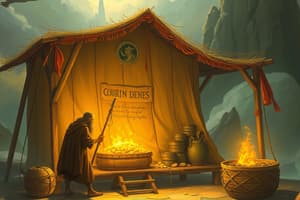Podcast
Questions and Answers
What is the main advantage of paper money compared to metal coins?
What is the main advantage of paper money compared to metal coins?
- It has intrinsic value.
- It has historical significance.
- It is more durable under harsh conditions.
- It is lighter and easier to transport. (correct)
What type of money derives its value from government endorsement?
What type of money derives its value from government endorsement?
- Commodity money
- Barter money
- Gold-backed money
- Fiat money (correct)
What is one of the key roles of central banks?
What is one of the key roles of central banks?
- To control inflation and stabilize the economy. (correct)
- To provide loans directly to consumers.
- To regulate international trade tariffs.
- To issue coins for daily transactions.
Which task is primarily associated with the European Central Bank (ECB)?
Which task is primarily associated with the European Central Bank (ECB)?
Who is the current president of the European Central Bank?
Who is the current president of the European Central Bank?
What does the ECB primarily manage in the eurozone?
What does the ECB primarily manage in the eurozone?
Which body within the ECB handles day-to-day operations?
Which body within the ECB handles day-to-day operations?
What is one of the roles of the Governing Council of the ECB?
What is one of the roles of the Governing Council of the ECB?
What is the Eurosystem responsible for?
What is the Eurosystem responsible for?
Which of the following is NOT a specific task of the ECB?
Which of the following is NOT a specific task of the ECB?
Who represents the ECB at high-level meetings?
Who represents the ECB at high-level meetings?
What is one of the responsibilities of the General Council of the ECB?
What is one of the responsibilities of the General Council of the ECB?
Which of the following functions relates to the ECB's oversight of financial markets?
Which of the following functions relates to the ECB's oversight of financial markets?
What is the primary problem associated with the barter system?
What is the primary problem associated with the barter system?
What does 'double coincidence of wants' refer to in the barter system?
What does 'double coincidence of wants' refer to in the barter system?
Which of the following describes commodity money?
Which of the following describes commodity money?
Where were the first coins created?
Where were the first coins created?
How did the introduction of coins impact trade?
How did the introduction of coins impact trade?
What was the first region to introduce paper money?
What was the first region to introduce paper money?
What is a significant drawback of transporting goods for barter?
What is a significant drawback of transporting goods for barter?
What factor necessitated the shift from barter to money as a medium of exchange?
What factor necessitated the shift from barter to money as a medium of exchange?
What is the primary purpose of monetary policy?
What is the primary purpose of monetary policy?
Which policy is utilized to decrease inflation?
Which policy is utilized to decrease inflation?
How does expansionary monetary policy typically affect unemployment?
How does expansionary monetary policy typically affect unemployment?
What can be a consequence of an increase in the money supply?
What can be a consequence of an increase in the money supply?
Which of the following is NOT a primary tool of central banks for monetary policy?
Which of the following is NOT a primary tool of central banks for monetary policy?
What is the monetary base?
What is the monetary base?
What effect does contractionary monetary policy typically have on interest rates?
What effect does contractionary monetary policy typically have on interest rates?
Which strategy is often used in monetary policy to influence economic activity?
Which strategy is often used in monetary policy to influence economic activity?
What components make up the monetary base?
What components make up the monetary base?
Which action by the central bank decreases the monetary base?
Which action by the central bank decreases the monetary base?
What happens when the central bank lowers the discount rate?
What happens when the central bank lowers the discount rate?
Which factor drives the demand for the monetary base?
Which factor drives the demand for the monetary base?
Equilibrium in the monetary base market occurs when:
Equilibrium in the monetary base market occurs when:
What is the result of excess supply in the monetary base market?
What is the result of excess supply in the monetary base market?
What can cause an increase in the banking system's demand for reserves?
What can cause an increase in the banking system's demand for reserves?
Which of the following is NOT a method the central bank uses to influence the monetary base?
Which of the following is NOT a method the central bank uses to influence the monetary base?
Flashcards are hidden until you start studying
Study Notes
Barter System
- The barter system is the oldest trade method, involving direct exchange of goods and services without money.
- Requires "double coincidence of wants," meaning both traders must want what the other offers.
Problems with Barter
- There is no common measure of value, making fair trade agreements subjective and difficult.
- Transporting bulky goods is impractical, which limits trade scale and complicates transactions.
- Growth in trade and economies highlighted the need for a standardized medium of exchange, leading to the development of money.
Early Forms of Money
- Commodity Money: Valuable in itself (e.g., gold, silver), serving as both a medium of exchange and a store of value.
- First Coins: Created in Lydia around 600 BCE, standardized weights, stamped symbols verifying authenticity and value.
- Coins enhanced trade efficiency and trust, being backed by authorities.
Introduction of Paper Money
- First introduced in China during the Tang Dynasty to mitigate the challenge of carrying metal coins.
- Benefits included being lighter and easier to manage in large quantities.
- Gradually spread to Europe in the 17th century, adapted to local economies.
Evolution of Modern Currency
- Fiat Money: Currency with no intrinsic value; value derives from government backing and public trust.
- Digital Money: Encompasses electronic banking and cryptocurrencies, representing the latest financial transaction evolution.
Role of Central Banks
- Central banks influence money supply, control inflation, and set interest rates to stabilize economies.
- The European Central Bank (ECB) oversees eurozone monetary policy and ensures price stability.
ECB Overview
- Established: 1998, Location: Frankfurt, Germany.
- President: Christine Lagarde, overseeing key monetary tasks.
- Governing Council includes the Executive Board and national central bank governors.
Functions of the ECB
- Sets eurozone interest rates, manages foreign currency reserves, and ensures financial market stability.
- Authorizes euro banknote production and monitors price trends affecting stability.
Monetary Policy
- A set of tools used by central banks to control money supply, promote growth, and influence economic stability.
- Influenced by economic indicators such as GDP and inflation rates.
Types of Monetary Policy
- Contractionary Policy: Raises interest rates, decreases the money supply to combat inflation.
- Expansionary Policy: Lowers interest rates to stimulate economic activity and reduce unemployment.
Goals of Monetary Policy
- Combat inflation and adjust money supply accordingly.
- Reduce unemployment by increasing available capital for businesses.
- Influence exchange rates through adjustments in domestic money supply.
Key Monetary Policy Tools
- Reserve Requirements: Adjusting required reserves influences how much banks can lend.
- Open Market Operations (OMOs): Buying/selling government securities to control monetary base.
- Discount Rate: Interest rate banks pay to central banks for borrowing reserves.
Monetary Base Dynamics
- Consists of currency in circulation and reserves held by banks.
- Central bank controls the supply primarily through OMOs, reserve requirements, and discount rates.
Demand and Supply of Monetary Base
- Demand driven by public needs for cash and banks' reserve requirements.
- Equilibrium occurs when supply meets demand; impacts interest rates accordingly.
Impacts on Interest Rates
- Excess supply lowers interest rates, while excess demand drives them higher, influencing lending practices.
Studying That Suits You
Use AI to generate personalized quizzes and flashcards to suit your learning preferences.




